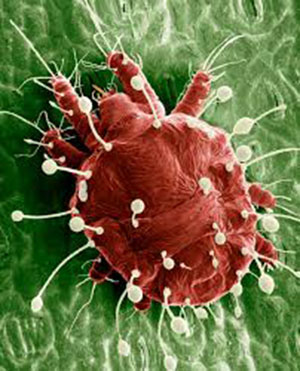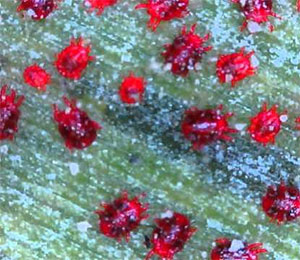The red palm mite (RPM), Raoiella indica, has continued to be a predominant and invasive pest of coconut and other palm plants in Guyana for the past three years after its first discovery on the island of Wakenaam (Guyana) in 2013.
 Ranking the third most important economic crop in Guyana’s economy, the coconut palm serves a multi-functional role in the agricultural sector. While the red palm mite’s potential impact on the coconut industry in Guyana is not yet known, it has been recorded that yields can be reduced in excess of 50% with crop losses ranging from 70-90%. For instance, in Trinidad, coconut production decreased by 70% within one year after the introduction of the invasive pest red palm mite.
Ranking the third most important economic crop in Guyana’s economy, the coconut palm serves a multi-functional role in the agricultural sector. While the red palm mite’s potential impact on the coconut industry in Guyana is not yet known, it has been recorded that yields can be reduced in excess of 50% with crop losses ranging from 70-90%. For instance, in Trinidad, coconut production decreased by 70% within one year after the introduction of the invasive pest red palm mite.
Control of RPM has become challenging for farmers since their only means of control is chemical application of miticides either by injecting or spraying onto palms. Agrochemicals have serious implications on both human and the environment; also pests are becoming resistant to these chemicals. Thus, the need for not only alternatives, but sustainable methods of control is necessary.
Biological control is an alternative to the use of chemical pesticides. Biological control entails the use of predators and parasitoids (natural enemies/ biological control agents) to control a targeted pest. They feed on, compete with or otherwise inhibit pests and their population growth and spread there by, keeping them under the threshold level. 
Biological control has been around for decades and has been one of the safest methods of control for insect pest. They are target specific, economically viable in the long term and most importantly are sustainable and environmentally friendly. Based on literature, two species that have been found to have the potential for use as biological control agents for the Red Palm Mite are identified as the green lacewing, and a mite which feeds on the RPM: Amblyseius largoenesis. Experiments are ongoing to test the effectiveness of both of these natural enemies on the RPM.
Likewise, biological fungicides may act to suppress the population of the pathogenic organism through competition. Entomopathogenic fungi that infect insects have received considerable attention by scientists for their potential for biological control of pests. Some pathogenic fungi have restricted host ranges, while other fungal species have a wide host  range. These entomopathogens have contact mode of action in most cases.
range. These entomopathogens have contact mode of action in most cases.
It contacts the cuticle, forms appresoria, penetrates into the insect, proliferates, produces toxins and ultimately kills the insect. The insect host shows reaction of reduced or increased feeding, behavioural fever, aberrant mating, and changed ovipositional preferences.
Since this form of control is inexpensive, sustainable, environmentally friendly and easily available, the National Agricultural Research and Extension Institute (NAREI) seeks to test the effectiveness of the entomopathogenic fungi against red palm as an alternative method of control to chemical.
This fungus was used in Texas to evaluate its effectiveness against whiteflies and the results were positive, likewise in Africa this fungus has had the same success in the control of flea vectors of the plague. As such NAREI is using this background data as a foundation for their research.




.jpg)










